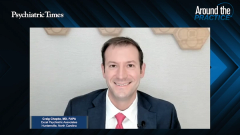
Prevalence of Adult ADHD
Stephen Faraone, PhD; Theresa Cerulli, MD; Craig Chepke, MD, FAPA; and Andrew J. Cutler, MD, discuss the prevalence of adult ADHD.
Episodes in this series

Stephen Faraone, PhD: Thank you for joining the Around the Practice Psychiatric Times Program on the management of ADHD. I'm Stephen Faraone, professor and vice-chair for research in the department of psychiatry at SUNY Upstate Medical University in Syracuse, New York. My colleagues now, introduce themselves, Doctor Cerulli.
Theresa Cerulli, MD: I'm Theresa Cerulli, I am a neuropsychiatrist in practice in the Boston area, president and medical director of my multidisciplinary practice, Cerulli & Associates in North Andover, Massachusetts, and I'm a lecturer and clinical supervisor at Harvard Medical School and Beth Israel Deaconess Medical Center in Boston.
Stephen Faraone, PhD: And Doctor Chepke?
Craig Chepke, MD, FAPA: Hi, my name is Craig Chepke, I'm a psychiatrist and medical director of Excel Psychiatric Associates, a private practice in Huntersville, North Carolina, and I'm also a clinical assistant professor of psychiatry at SUNY Upstate Medical University in Syracuse, New York.
Andrew J. Cutler, MD: I'm Doctor Andrew Cutler, I'm thrilled to be here with my good friends and colleagues. I am a clinical associate professor of psychiatry also at SUNY Upstate Medical University, where we obviously have a very strong ADHD department, and I'm the chief medical officer of the Neuroscience Education Institute, and I work remotely from Lakewood Ranch, Florida.
Stephen Faraone, PhD: In addition to reviewing the diagnosis and management of ADHD with these experts in the field, we will also present 3 patient cases and talk through approaches to treatment. I'm going to start with a question that's very easy, what is the incidence and prevalence of attention deficit and hyperactivity disorder in the adult population? There are many studies, probably the best in the United States, by puts the prevalence at about 4.5%, that means about 12 million adults in the United States have attention deficit and hyperactivity disorder. It also means many of them are in your practices and require treatment.
Andrew J. Cutler, MD: Yes, no problem. You know, Steve, this is sort of the classic numbers that we hear, and there's also controversy about how often ADHD persists from childhood into adulthood, but I think it's fair to say that some of our estimates are looking at point prevalence, periods in time, but certainly my clinical experience, when I follow people over time sometimes the presentation can wax and wane, either the symptomatology or the impairments, and sometimes it has to do with the environment, its stressors and various things going on. There's a recent study that was published by Margaret Sibley and colleagues that suggests this may be the case.
Stephen Faraone, PhD: That's very true, Andy, the cross-sectional studies suggest that about a third of people with ADHD will not have ADHD in adulthood when examined one point in time. And we don't know if this waxing and waning will be validated in other studies, but that's important data to look for, in the future, it tells the clinician that, if their patient appears to go into remission, you still need to follow up and make sure that the ADHD symptoms don't reemerge, because maybe the patient is facing new challenges that lead to symptom expression.
Theresa Cerulli, MD: And Steve, that's exactly what we do in my clinic. My area of interest within neuropsychiatry has been ADHD for the past 20 years, and part of me was already interested when I was doing my neuropsychiatry fellowship and working with adults with ADHD and what I've seen in clinical practice is this waxing and waning picture of ADHD symptomatology that even, if someone isn't meeting full criteria for ADHD, they're often still symptomatic and having functional impairments with ADHD, and depends on what's going on in their lives that may exacerbate and, or help to improve symptomatology in the way it presents, I picture, thinking like MS, this remitting relapsing picture, of course, with ADHD, that's how I explain to my patients, it's more rare to see somebody go into quote remission and stay in remission with their ADHD, it is this kind of a sine wave, sine wave curve that I think about, with the longitudinal perspective.
Craig Chepke, MD, FAPA: One point that I'd like to make is that, the DSM-V did a good job of is that it moved ADHD to the neurodevelopmental disorder section, right between autism and specific learning disorder, and just like we tend not to think that people grow out of autism, that I tend to think that people don't grow out of ADHD, it's just they may get into situations and environments where they have coping skills, they have other advantages, as my colleagues have mentioned, and that they may not meet criteria, which, there again, the criteria were designed for children and adolescents, not adults, so we have that problem as well when looking at prevalence of adults with ADHD.
Stephen Faraone, PhD: You raise a key point there, because when the DSM-5 was being created, some of us advocated that symptoms of emotional dysregulation should be added to the criteria, because they become more prominent in adolescence and adulthood than they are in childhood that, sometimes, what appears to be remission is really shifting its symptoms from hyper, lot of hyperactivity and inattention to more inattention, emotional dysregulation and executive disfunction. And this is something that clinicians must struggle with because the criteria have shifted. I want to also underline what Dr Cerulli said is that, if a patient has had history of ADHD and, after a period of time, they're only showing a few symptoms, they're still impaired, they still have ADHD, we don't require that they have to have the full symptom count to require treatment, it would be a mistake to deny treatment to those people.
Transcript edited for clarity
Newsletter
Receive trusted psychiatric news, expert analysis, and clinical insights — subscribe today to support your practice and your patients.






















